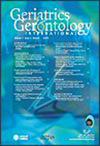Glucocorticoid usage is involved in the improvement and development of frailty in patients with rheumatoid arthritis: Results from the PRESENT study
Abstract
Aim
This longitudinal cohort study examined the development and improvement of frailty. We analyzed baseline factors and 1-year changes to identify ways to prevent frailty and preserve quality of life in patients with rheumatoid arthritis.
Methods
A total of 160 patients with rheumatoid arthritis from the multicenter, prospective prospective observational cohort study were analyzed over a 1 year. Among the 104 robust or prefrail patients at baseline, those who progressed to frailty were classified as frailty development, whereas those who remained robust or prefrail were frailty undiagnosed. Among the 56 frail patients, those with improved frailty were classified as frailty improvement, and those who remained frail were classified as frailty continuation. The correlations between frailty development and improvement, baseline factors, and parameter changes were examined using univariate and multivariate logistic regression analyses.
Results
A total of 94 (90.4%) patients were frailty undiagnosed, and 10 (9.6%) were frailty development. Glucocorticoid usage (OR 6.21) and changes in the modified Health Assessment Questionnaire (ΔmHAQ; OR 1.49) were identified as a significant factor for frailty development adjusted for age, sex, disease activity score composite of the ESR and the 28-joint score, biological/targeted synthetic disease-modifying anti-rheumatic drug usage and mHAQ at baseline. A total of 28 (50.0%) patients were in the frailty continuation group, whereas 28 (50.0%) patients belonged were in the frailty improvement group. Glucocorticoid usage (OR 0.23) and ΔmHAQ (OR 0.75) were identified as significant factors for frailty improvement adjusted for age, sex, disease activity score composite of the ESR and the 28-joint score, biological/targeted synthetic disease-modifying anti-rheumatic drug usage, and mHAQ at baseline.
Conclusions
Avoiding glucocorticoid use and improvement of quality of life are key to preventing and overcoming frailty in patients with rheumatoid arthritis, and potentially extending their life expectancy. Geriatr Gerontol Int 2025; 25: 1231–1238.

 求助内容:
求助内容: 应助结果提醒方式:
应助结果提醒方式:


